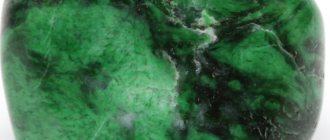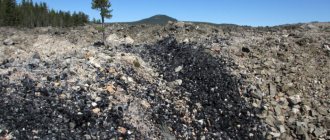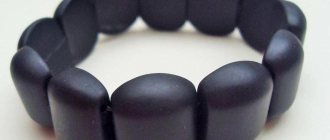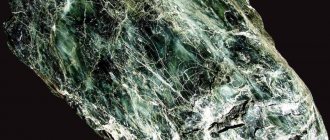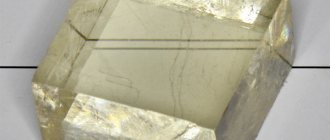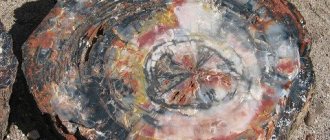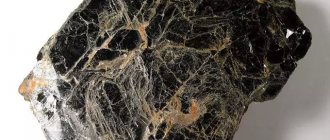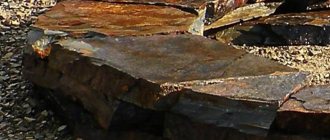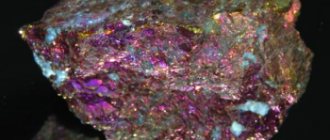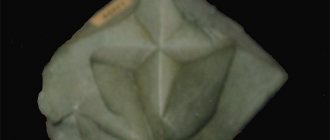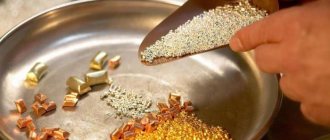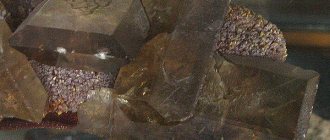Like many other rocks, kaolinite gets its name from the place where it was discovered. It was first discovered in China near the settlement of Yauha Fa, located on a high hill. And the expression “high mountain” or “high hill” in Chinese sounds like “kao ling”. Exactly when kaolinite was discovered by the Chinese is unknown, but considering the quality and beauty of ancient Chinese porcelain, the main component of which is kaolin, it was a very long time ago. It is quite possible that the extraction and use of rock in China were classified in the same way as, for example, the production of natural silk. Be that as it may, Europeans learned about the existence of kaolin rocks only at the end of the 19th century.
Like many other rocks, kaolinite gets its name from the place where it was discovered.
Physical properties
Optical
- The color is white, due to impurities it can be different shades of yellow, greenish, bluish, red, colorless in small scales.
- The line is white.
- The shine of the units is matte.
- The sheen in solid masses is matte. Thin scales have a pearlescent tint.
- Transparency. In a piece it is opaque, but individual leaves are transparent.
Refractive indices
Ng = , Nm = and Np =
Mechanical
- Hardness 1.
- Density. 2.58—2.60.
- Cleavage is perfect, but macroscopically not determined.
- Kink. Shellish, earthy.
Chemical properties
Behavior in acids. Decomposes into H2SO4.
Other properties: greasy to the touch, when dry it easily absorbs moisture (sticks to the tongue), when wet it forms a plastic mass.
Diagnostic signs
Similar minerals are montmorillonite, sericite.
Identified by its clay-like appearance, softness, and oiliness to the touch. Similar to dense earthy calcite, but does not react with hydrochloric acid. To distinguish it from other clay minerals, special diagnostic methods are needed.
Associated minerals. Feldspars, opal, limonite. feldspathoids, muscovite, quartz, zircon, cassiterite, etc.; For the most part, they are found as relics in the kaolinite mass.
What is kaolinite and kaolin
Kaolinite is a mineral containing feldspar. When rock is processed, white clay (kaolin) is obtained.
Description of clay rock:
| Kaolinite | Kaolin (raw) |
| Clayey loose stone with a Mohs hardness of 2–2.5 points | A dusty rock that is white, gray, cream, or other light colored |
| The color is white, with a transition to yellow, cream, green, blue or red. There are brown spots | The deposit consists of a solid massif |
| The shine is dull, with a pearlescent tint | When moistened, it becomes slimy, plastic, soft |
| Opaque, thin plates show through under directional lighting | Splinters or rubs with slight pressure or impact |
| The break is uneven | May include sand grains or carbonate particles |
The name “kaolin” comes from the name of the territory in China - Gaoling District (High Mountain). Kaolinite continues to be mined here.
There are large kaolin deposits in the territories of Ukraine and Russia. The famous quarries are the Zhuravliny Log and the Kyshtymskoye deposits.
See the review of the mineral:
Properties and uses of kaolin
Kaolinite has a crystalline structure. When viewing the surface under magnification, small particles are visible. When splitting, the fracture becomes smooth, rough or conchoidal.
The chemical composition of the mineral contains oxides of aluminum (up to 40%) and silicon (up to 47%). The formula is written as Al4[Si4O10](OH)8. For kaolin clay, the notation is slightly different: Al2O3–2SiO2–2H2O.
Mechanical properties of clay rock:
- fireproof (withstands up to 1770 ºC, does not melt);
- has average ductility (number from 25 to 44);
- binds mortars poorly;
- good covering ability (when whitening it fills small cracks and pits).
Optical properties depend on the amount of remaining impurities. Regular grade kaolin powder has worse color and light reflection. Purified clay has a snow-white, green, pale blue, pink color, and has no abrasive particles or other inclusions. This improves the brightness of the powder. Refractive index no less than 1550.
Dispersed kaolin powder is used in the paint and varnish and paper industries, in the production of porcelain, plastics, electrical ceramics, and rubber. Purified kaolin is used in pharmacology and cosmetics production.
Clay has an unlimited shelf life, and its composition is rich in minerals that are beneficial for skin, bones, and metabolism.
View this post on Instagram
Publication from ?Mineral cosmetics from the USA? (@secondskin_minerals) Jan 23, 2021 at 11:19 PST
In medicine and pharmaceuticals
Highly purified kaolin powder is used as a tablet filler (it binds pharmaceutical substances in pills). Calcium gluconate or other enriched white clay products are prescribed internally as a source of microelements. The powder is rich in silicon, zinc, aluminum, calcium.
Kaolin is used for thermal physiotherapy. Compresses or poultices accelerate the healing of bruises, sprains, and cure joint diseases.
White clay is also an enveloping, cleansing substance. The sorbent is prescribed orally for vomiting, diarrhea, and other signs of food poisoning or intestinal infection. The product cleanses the liver and helps expel small stones and sand from the gallbladder.
Research on kaolin has revealed its anti-inflammatory properties. When consumed internally, clay neutralizes the effects of free radicals, improves metabolism, and stimulates collagen formation.
View this post on Instagram
Posted by Eco Shop Zaryanica (@zaryanica_eco) Oct 30, 2019 at 9:15 PDT
To watch a video about the use of clay as a sorbent:
Deposits and production
Kaolinites occur both within the continental part of the earth's crust and in the zone of the ocean floor. The mineral is formed through a process called kaolinization, which is accompanied by chemical weathering and hydrothermal alteration of feldspars and other silicates.
The mineral kaolinite is found in various clays, marls and shales. Its largest deposits are located in the southeastern part of China. High-quality kaolins are also mined in Russia (Ural), Ukraine (Zhitomir, Kiev and Ternopil regions), Great Britain (Cornwell), Germany (Meissen, Halle), Czech Republic (Sedlce), Uzbekistan, Kazakhstan and Bulgaria.
It is worth noting that the process of extracting kaolins from the earth’s crust is not particularly expensive. They are mined mainly by open-pit (quarry) method. For example, this is what a clay quarry looks like in Ukraine (the city of Terebovlya, Ternopil region):
But this is the appearance (photo below) of already mined and crushed kaolinite in Spain.
Mineral kaolinite: application today
It is not difficult to guess that the main consumer of this mineral is the porcelain and ceramics industry. It is worth noting that making high-quality porcelain is a rather complex and troublesome process. Fortunately, the stone itself is not rare and is easy to obtain. Porcelain is made from purified kaolinite. It is first removed from various impurities in centrifuges and hydrocyclones. After this, the raw materials are dehydrated in order to reduce weight and increase the strength of the final product.
In addition, the mineral kaolinite is also used in the production of coated paper, artistic glaze, and toothpaste. Industrial filters, electrical insulating gaskets, and thermal insulation materials are made from kaolin wool. Plus, kaolins (white clay) are widely used in cosmetology and folk medicine. Thus, the volumes of kaolinite consumption in the modern world are quite substantial.
History of the use of the mineral
As mentioned above, there is no information about how long ago the Chinese discovered kaolinite. But they were the first to do it. At least this is evidenced by the highest quality of ancient Chinese porcelain. Back in the third century BC, Chinese craftsmen created their unique “Terracotta Army”, consisting of eight thousand clay statues of warriors and horses.
The technology of processing kaolinite into “white gold” was kept secret by the masters of the Middle Kingdom for a long time. In Western Europe and Russia, they learned to make porcelain only in the 18th century. The first factories sprang up in Meissen, Germany, and Sèvres, France. In 1744, the Imperial Porcelain Factory was founded in St. Petersburg, operating to this day.
Stone from the "High Hill"
This soft mineral with an earthy luster is widespread on our planet. But it was first discovered by the Chinese near a village located on a high gentle hill. The village was called Kao-Ling, which means “High Hill” in Chinese. By the way, this is where the term “clay” comes from. It is unknown when exactly the mineral kaolinite was discovered by the Chinese. However, Europeans learned about its existence only in the century before last.
You may be interested in: Method of strictly regulated exercise: essence, application, reviews
The mineral kaolinite belongs to the class of hydrous aluminum silicates. Its formula is as follows: Al4[Si4O10](OH)8. The chemical composition of kaolinite is as follows:
- Silicon dioxide – 47%.
- Aluminum oxide – 39%.
- Water – 14%.
It is necessary to distinguish between the concepts “kaolinite” and “kaolin”. The first is a mineral, and the second is a rock. Kaolinite is the main component of most clays.
Main varieties of mineral
In fact, by kaolinite, geologists mean a fairly large group of different minerals. The most common among them are:
- Rodalite.
- Terratolite.
- Keffekelit.
Rodalite is a mineral with a pink tint due to iron impurities. Mined in Northern Ireland. Terratolite is a mixture of quartz, mica, limonite and, in fact, kaolinite. The color of the mineral is blue-violet. Keffekelite contains impurities of halloysite and some other clay minerals and is distinguished by greenish-yellow tints. In China there are also deposits where a mixture of kaolinite with dickite, quartz and cinnabar is mined. This mineral has a specific name - “chicken blood”.
It would be worth noting that some varieties of kaolinite are quite beautiful. Therefore, they are actively used in decorating furniture and inlaying jewelry.
Clay in cosmetology and folk medicine
All cosmetologists know about the healing properties of the so-called white clay. The latter acts as an absorbent: cleanses the skin, removing toxins and impurities from it. After clay masks, the skin looks fresher and healthier, small wounds heal and scars heal. Kaolin also has a beneficial effect on hair, preventing it from becoming brittle.
In folk medicine, clay helps with sore throats and headaches. To do this, apply a thin layer of it to sore spots. Some healers are convinced that kaolin can cure a person from such serious ailments as arthritis and pneumonia. White clay is also used to make tooth powder. For gastrointestinal disorders, flatulence, and alcohol poisoning, clay is taken orally (of course, in small quantities).
Grades and subgroups of mineral
Based on the formation of the rock, primary and redeposited kaolin are distinguished. The first is formed during the weathering of sedimentary clay or granite, shale. The second type is also called kaolin clay, or kaolinite. It is a mineral-enriched soft rock.
In industry, primary kaolin is often forcibly enriched. After processing the rock, the properties inherent in kaolin clay appear.
Subgroups of kaolin rock:
- Milosit - green, the color comes from an admixture of chromium;
- “chicken blood” is red, there is dickite, cinnabar, quartz;
- rodalite - pink, contains iron;
- keffekelite - green-yellow, includes halloysite;
- terratolite - blue-violet, contains an admixture of limonite, mica, quartz.
They produce 5 grades of clay:
- Regular kaolin powder is of low quality. This is a rock washed in water. Then the impurities are removed in a centrifuge, and the residue is dried. Additional bleaching is required.
- Delaminated kaolin has the best quality. It is obtained by grinding washed clay (regular brand). After processing, the brightness and barrier properties of the powder improve.
- Calcined kaolin is produced by heating washed bleached rock at temperatures above 1000 ºC. During processing, hydroxides are removed, porosity and brightness increase, and specific gravity decreases. The powder's color, hiding power and matting properties are improved.
- To obtain dry-ground kaolin, impurities are separated with air. After crushing, the powder retains high abrasiveness of the particles and a dull color.
- Dispersed kaolin is obtained by grinding bleached rock into a fine powder. Used for filling paint and varnish solutions.
